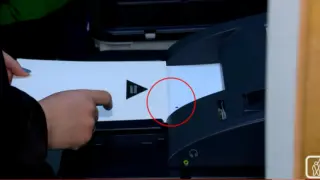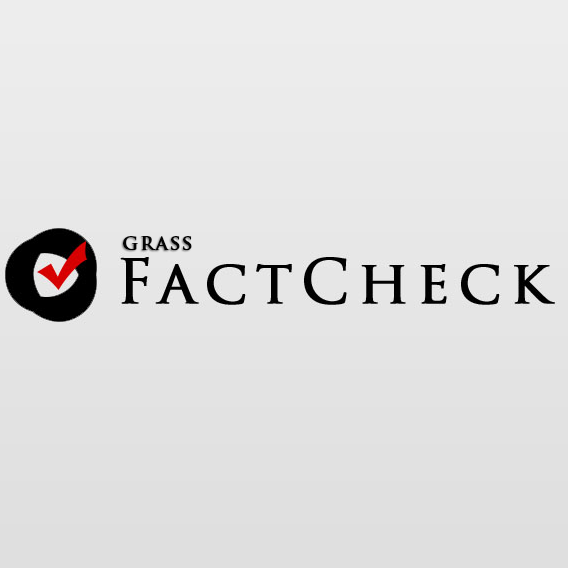According to monitoring organisations, media and voters, the principle of vote secrecy was breached during the 26 October parliamentary elections in Georgia. They claim that there is photo and video evidence to support this (see footage documenting vote secrecy violations).
A breach of vote secrecy also constitutes a violation of the Constitution of Georgia and the Election Code of Georgia. The Constitution mandates that elections are conducted by secret ballot. Furthermore, the secrecy of voting and free expression of voters’ will are fundamental principles of the electoral process according to Article 3 of the Election Code.
Reports suggest that a marker-coloured circle next to the chosen electoral subject was clearly visible on the other side of the ballot, allowing the voter’s choice to be identified when the ballot was placed into the vote-counting machine (refer to video evidence).
It was straightforward to deduce a voter’s choice given the layout of electoral subjects on the ballot. In particular, if marker traces appeared in the upper half of the ballot’s backward side, it decisively indicated a vote for the opposition party (the ruling party’s number 41 was the last one on the ballot). Additionally, members of the Central Election Commission (CEC) assigned to vote-counting machines frequently placed ballots in the machine on behalf of the voters. Moreover, there were cameras installed in many precincts by the Georgian Dream political party, mostly directly facing the vote-counting machine (see footage). Notably, throughout the election day citizens often also reported seeing marker traces on the back of the ballot.
The Georgian Young Lawyers’ Association (GYLA) cites vote secrecy breaches and influence on voters’ choice as key issues in its Assessment of the Voting Day, identifying incidents such as following voters into booths, taking photos or videos and other violations of privacy. “At the majority of precincts observed by GYLA, video cameras installed by the Georgian Dream party were noted which in some cases faced the registrars’ tables and verification devices and, in others, the voting booths and main ballot box. The quality of the ballots did not prevent coloured marks from being left on the reverse side. The concurrence of these two factors significantly raises the risk of undue influence on voter will. Additionally, various episodes of secrecy violations were recorded, including instances where voting occurred alongside unauthorised accompanying persons” – reads GYLA’s statement.
Consequently, GYLA is requesting annulment of the results from all polling stations (2,263 stations) where voting technology was used due to violations of voting secrecy. They argue that “the principle of voter secrecy was widely violated on election day, infringing upon the constitutional electoral rights guaranteed by the Constitution of Georgia.”
GYLA claimed: “Notably, GYLA discovered the risks of violation of the vote secrecy at the training and information meetings held by the CEC prior to the elections, communicating these concerns to the CEC in advance to take appropriate measures. By letter No. 01-01/1607 dated 28 September 2024, CEC informed GYLA that the ballot used at the training and information meetings held by the CEC was a test version and that the quality of the ballot used on election day would be different, ensuring confidentiality. However, this assurance was not fulfilled.”
FactCheck Georgia also communicated with CEC representatives regarding the aforementioned issue when the CEC presented election technologies to FactCheck Georgia on 18 July, 2024. At the meeting, the marker’s traces transferred to the reverse side of the ballot that was used by the CEC for illustrative purposes at FactCheck Georgia’s office. On this, CEC representatives asserted that the ballots used were only trial versions and higher-quality ballots would be printed for the elections which would not transfer any traces to the back [1].
Giorgi Sharabidze, the Deputy Chairman of the CEC, addressed the issue of vote secrecy on 30 October. He explained that “the ballots were printed on high-grammage offset paper which is significantly thicker than the ballots used in the 2021 elections in the Krtsanisi district.”
Notably, Giorgi Sharabidze emphasises the thickness of the ballot in his explanation. In reality, the CEC’s assurance was not about the thickness of the ballot but rather its quality, meaning that the marker traces should not have left any marks on the reverse side of the ballot. The CEC had assured that ballots of different quality would be used on the election day to prevent breaches of the secrecy of vote (see video footage clearly showing the marker traces on the back of the ballots).
Afterwards, Giorgi Sharabidze shifted the focus to the frame envelope. He stated: “The special frame envelope was made by the CEC with thick paper, ensuring that if the ballot was placed correctly, the secrecy of vote was fully protected.” However, the assertion that the frame envelope alone could guarantee complete vote secrecy is contradicted by the aforementioned letter by the CEC to GYLA in which the Chairman of the CEC underlines the improvement of the quality of the ballot paper to ensure secrecy of the vote.
The video that FactCheck Georgia filmed at the CEC and published before the elections shows that despite the ballot being placed in a frame envelope, the traces of the marker are clearly visible on the back of the ballot during the inserting process. This occurs despite the ballot being inserted into the vote-counting machine under direct supervision of a CEC representative who voiced no objections during the process. This is natural, since the statements and expectations of the CEC representatives were that there would be no traces of the marker on the other side of the ballots used in the voting process on election day, and therefore, the secrecy of the vote would not be protected only with a frame envelope. During the same meeting, CEC representatives reiterated that this was merely a trial ballot and higher-quality paper would be used for the ballots in the elections, which would not show any marker traces on the back.
The Deputy Chairman of the CEC acknowledged that marker traces were visible on the back of the ballots but downplayed the issue. “Based on the information reported, there is a kind of bleed-through on the back of the ballot; however, it can certainly be said that it is impossible to definitively and clearly determine the voter’s choice” – claimed Giorgi Sharabidze.
The Chairman of the CEC, Giorgi Kalandarishvili, also acknowledged that whilst marker traces were visible on the ballots, vote secrecy was not compromised on 30 October. “No one is denying that traces were visible; the commissions saw it all on election day. However, this does not mean that anyone’s choice was revealed” – stated Kalandarishvili.
The presence of marks on the back of the ballot indeed indicates a breach in the privacy of the vote, according to the OSCE/ODIHR preliminary report on 27 October. [2]
FactCheck reached out to the CEC with questions on this issue. The full questions and answers can be found at the provided link.
In summary, CEC representatives attributed the marker traces on the reverse side of the ballot to the use of test ballots, including during their visit to the FactCheck Georgia’s office, assuring that this issue would not occur during the actual election day.
Furthermore, it is inaccurate to claim that the secrecy of the vote could not be compromised solely due to the marker trace as the electoral subject’s data and serial numbers were not visible on the back. In reality, as mentioned above, if a voter chose, for instance, one of the first ten subjects, it would be straightforward to decisively identify that the voter had decided not to support the ruling party. This potential for identification infringes vote secrecy.
Notably, FactCheck Georgia does not address the relevancy of paper thickness to the standard. Through multiple communications with the CEC, including during their visit to FactCheck Georgia, it is evident that the assurance regarding paper thickness was made in the context of preventing marker bleed-through on the back of the ballot, which could potentially reveal the voter’s choice. Therefore, increasing paper thickness was not an end goal in itself but was intended specifically to eliminate the risk of such visibility.
Evidently, polling stations on the election day did not have ballots of a quality sufficient to prevent marker-coloured circles from being visible on the back.
[1] Question: “If someone were to observe the ballot, they could have theoretically memorised the list of electoral subjects and deduce the voter’s choice from the back of the ballot.”
Answer: “This is a test version of the ballot. The traces will not be visible there [on election day]. The chalkiness will be increased”.
See the video.
[2] OSCE/ODIHR Observation Mission, Preliminary Conclusions, pg. 20: https://www.osce.org/odihr/elections/georgia/579346
Picture: TV Formula







